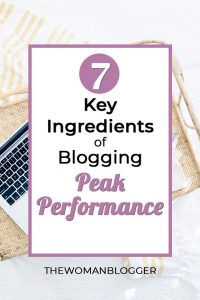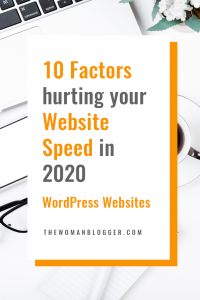When I started blogging there was a lot of overwhelm and burnout. I had little idea of how to build a system that won’t burn me out. There is a lot of advice out there. While something might work for someone, it might not work for you.
So, here is the blogging schedule that actually worked for me. You can tweak the sequence as per your liking but remember to assign days/hours to all these tasks for the most optimal results in your blog traffic.
Why do you need a Blogging Schedule?
Whether you are running a business or just a blog, you need readers to come and read your content. Believe me, when I say, there are one hundred and twenty-one hurdles in your way. If you don’t develop a routine you won’t be accomplishing your blogging goals.
Every small business needs to have a blog to educate its readers about their products or services. You need a blog as a base for your sales or marketing funnel. The sooner you start to stick with a routine the better your results will be.
My 7 Step Blogging Schedule to Ace the Game
Before we start here is a brief precap of what we will cover.
- Why research day is important for your blogging schedule
- Write killer content for your blog posts (how)
- Optimize your posts for Google SEO
- Create social media graphics
- Create freebies for your posts
- Things to do as you proofread and publish
- Promote, promote and promote (how)
Step #1 Keep a day for Blog Research

Well-researched is well-written. Always remember that. When you know what you are going to write about, writing becomes a tad bit easy.
Don’t expect to write posts as you research them. Brainstorm well so that you have all your ideas on the table before you develop your first draft.
Initially, when you are just a newbie blogger researching for blog post ideas will be a task but as you move on in your journey, you will find your direction. You will understand your audience well and your research will be better too.
Step #2 Write a Killer Post
Write a killer post, yes! Before starting a blog I’m sure you must have been sure about one thing. That you can write. Not talking about writing like pro bloggers but writing like someone whose writing is understandable and digestible for their readers.
Before starting my blog, I had fairly complex vocabulary. That’s because as a child I was often found sitting on my thesaurus. In my undergraduate years, I started writing for various societies and programs at my university. They needed technical writers and my writing style was apt. But when I started blogging, friends and other readers identified how my writing was a bit complex to understand.
I had to work on simplifying it and for good. Not only did this help me secure hundreds of jobs as a freelance writer but it also helped me reach out to my readers well.
Does word count matter?
Yes and No!
It depends on the type of content you are writing. If it’s a tutorial that can help someone with fixing their WordPress Memory Limit Error in under 1000 words, sure why not. But if you are trying to cover a topic that could be explained in detail, go for the long-form.
Remember, you are not just trying to fill in the word count. The intent should be to help your user make the most of your information.
As of 2020 long posts work well for Google SEO. In any case, try and give at least 1000+ words of meaningful content to your readers. Do focus on the user experience.
Step #3 Optimize your Post for SEO
Focus on Google and Pinterest from the very start of your blogging journey. It will build slowly but will be of great benefit to you. Simply put, you need to do the following for on-page optimization of your blog posts:
- Research for a keyword (actually a key phrase) for each post. Go for long-tail keywords as opposed to short-tail ones. Like, go for Best Green Ramadan Recipes of 2020 instead of recipes.
- Find relative keywords and integrate them in your post as well. Remember, Google is looking for semantic and contextual data for ranking your website. There is no shortcut. Just hard work.
- Add your keyword in the URL of your post to make it more discoverable. [Read more: Optimizing Your WordPress Link Structure for Better SEO]
- Add keywords in the blog title, headings, and subheadings for your posts. [Read more: 10 Tips to write blog posts like professionals]
- Add images and alt-tags. Use keywords in alt-tags. Alt-tag is what your user sees when the images don’t load. These are good for SEO as they help search engines know more about your content. Do add relevant images to your posts. Don’t overpopulate your alt-tags with your keyword. It should look natural.
- Optimize the SEO and readability sections in the Yoast SEO Plugin. Make sure you fill the SEO title and meta description with the right keywords.
- Link your content to other related content on your website and to other websites as well.
Related: How to SEO your blog post in 10 simple steps
Some other things that come in favor of SEO are:
- Using frameworks like WordPress to build your websites. WordPress is very optimized for SEO.
- Making use of Google Analytics for your site’s data to see which posts are ranking high and which aren’t.
- Use Yoast SEO to automatically check for the basic on-page SEO.
Step #4 Create some awesome Social Media Graphics

Social media is where you’ll find a good number of your readers/buyers. We all are there for some part of our day. We love to follow our favorite content creators there.
So, create great social media graphics for all your social accounts. Initially focus on one or two. Build an audience there and then start with another one. Remember, to make all your accounts when you start your blog.
Let them sit there until the time you need to use them to start promoting your blog. This is so that you have your digital real estate booked on all sites. We’ll come and build our home there later on.
If not all, then focus on the more popular ones like Facebook, Instagram, Twitter, Pinterest (although a search engine), and LinkedIn.
Too busy to craft amazing brand-specific graphics for your blog posts? Check out my Social Media Graphics Package for monthly done-for-you graphics right at your PC steps. Have something specific? Or need to follow a budget? Contact me with your details and I’ll be sure to follow back with some insights.
How much to post?
From every blog you are writing you can create somewhere from 30-50 posts for all your blog promotion. Here is how to go about it:
- 4 to 7 Pinterest Graphics
- 10 to 15 Twitter Posts
- 4 to 7 Instagram Stories
- 3 to 5 Instagram Posts
- 2 to 3 Facebook Status Updates
- 3 to 4 LinkedIn Status Updates
Remember to make all these graphics different from each other. You don’t want to hurl the same thing to your reader again and again.
Step #5 Time for a Freebie
One of the best ways you can make use of your Google Analytics data is by cashing your top-performing posts. Here’s a trick. Every month go check your stats and look for the top ten posts in terms of traffic. From here on you can do either one of these two things:
- Content Upgrade
You can go up another step in your funnel. Offer a freebie aka content upgrade to your reader. This is something that adds more value to your existing content. It could be an ebook, a checklist, or a cheat sheet. - Affiliate Links
Add relevant affiliate links to these posts. Since they are already performing better and attracting a significant number of audience, it’s a bright idea to make some money off it. Remember to save your reputation, offer only those products that are actually good and of some value to your reader.
Step #6 Proofread and Publish your Post
It’s veryyy important to proofread your content before you hit publish. Your readers need to make sense out of your content and we all make silly mistakes when writing. I make silly mistakes in all walks of my life.
Jokes apart. Come back to your post on any other day after you’ve written it and look into it carefully. Find out all those spelling and grammatical mistakes and get rid of them.
Or hire someone to do that for you. Or get Grammarly. While it is not 100% right all the time, you still get a pretty good readable blog post that is not filled with silly mistakes.
Step #7 Promote Promote Promote
You optimized your post for Google SEO, now don’t wait for free organic traffic to start coming your way right away. Google will take some time to analyze your website and user experience. It will then see if your posts can rank for some of the popular searched keywords out there.
Meanwhile, we don’t want to hear crickets on our amazing blog posts too. So, promote your content on social media. If you are a beginner blogger focus on one or two social sites like Facebook, Instagram, and LinkedIn. Pinterest is a must for anyone who is into blogging. This amazing visual search engine has proven to show many bloggers amazing results in terms of traffic.
To promote on Youtube, convert your posts into videos by taking out some meaningful information and drafting an amazing script out of it. You don’t have to be perfect to start.
Other social media sites to promote your blog posts are:
Other places to promote are:
- Medium
- Quora
- Blogger
- Bloglovin’
Make use of your creative juices and promote, promote, promote.
Summary
So, our 7 step action plan for blogging success follows:
- Research your posts in advance
- Write good quality and detailed post
- SEO optimize your post
- Make social graphics for the post
- Integrate a freebie
- Proofread and publish the post
- Promote it away
What are your essential steps in your blogging journey? Are you making time for these seven crucial steps to ace your blogging schedule?
Pin It





